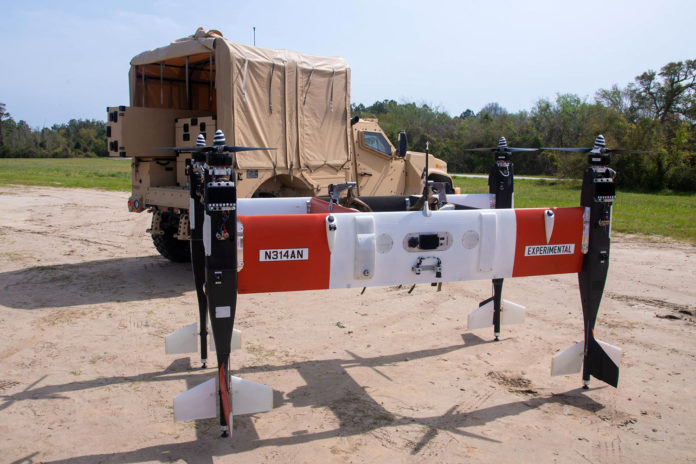Bell has demonstrated the aerial resupply capability of its electric-powered, Autonomous Pod Transport (APT) quadcopter drone. The new capability will eventually lead to quicker resupply missions for troops in challenging locations or out on battlefields.
Unlike any typical quadcopter, the APT takes off vertically and transitions to wing-borne flight, providing multi-copter payload capability with fixed-wing speed. This allows the aircraft to reach an incredible speed and range. Designed to carry a payload of up to 100 lbs (45 kg), the APT can fly with a top speed of 62 mph (100 km/h) for up to 35 miles (56 km) on a single charge.
What makes the APT stand out is its ability to take off with two standard tactical packs, each capable of holding up to 60 lbs (27 kg) with a max payload of 100 lbs (45 kg). These bags can be aerial dropped at one location or two separate locations and hold items such as ammo cans, water, medical supplies, or fuel.
It can also fly at speed to its destination and drop the supplies without landing or hovering for any length of time. This key vehicle feature conserves battery power by minimizing hover time – extending its mission range and time – and increasing the survivability of the aircraft. The aerial supply-drop feature demonstration fully showcases APT’s ability to enable faster and more efficient resupply for future warfighters.
“This speed bag resupply feature is a game-changer for the warfighter,” said Mike Goodwin, sales and strategy manager. “With the ability to drop supplies quickly and efficiently in a drop zone or a remote location, we can get critical supplies delivered as soon as they’re needed.”
Bell says the APT flight test program has already completed over 420 flights at Yuma, Camp Lejeune, Fort Benning, and other test sites. The cargo drone is expected to achieve other significant milestones by early 2022. The next step in the program will be to demonstrate precision aerial supply while flying at an 80 mph (129 km/h) cruise speed.
